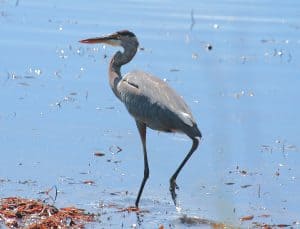
The Dinosaur vs. the Mammal
This month we have been witnessing an ongoing battle between a dinosaur and some mammals, which reminds me of tales of the Jurassic era. Making a complex subject overly simple, here’s the way I learned it: about 200 million years ago, when dinosaurs ruled the earth, tiny mammals had to stay hidden in burrows to avoid being eaten. After a huge asteroid hit the earth and enveloped it in darkness, the large dinosaurs became extinct. But small feathered dinosaurs remained to evolve into birds. Mammals, now free to come out in the open, evolved to become larger mammals, with larger brains and more intelligence. But I have come to doubt this last part of the story—the part about relative intelligence.
Our visiting dinosaur is a wily great blue heron, and the mammals of this tale are various anxious chipmunks who reside in our yard. The heron, who I imagine is a nesting female, discovered a great source of easily obtained nourishment for her young–chipmunks. She noticed that our bird feeder was an irresistible magnet for chipmunks, who have made a tunnel right under the feeder. This was intelligent on the chipmunks’ part because it avoids the need to run across open lawn to access the seeds that have fallen under the feeder; they only need to pop out of the hole, grab some seeds and take them into the tunnel.
But the heron (who does indeed resemble her dinosaur ancestors) seems even more intelligent. She stalks so slowly that one can hardly see her moving, then swiftly grabs her prey without a miss and flies away with it. One would think that she would get all the yard chipmunks (I thought we had two or three) within a day or two. But the heron knows better. She has been here two or three times a day for the past month, and has successfully bagged her prey each visit.
The chipmunks have now gotten a bit more wary before coming out of their hole, so the heron has had to change her strategy–an exit to entrance strategy. With this strategy, she first hides in the woods for a bit keeping her eye on the action at the bird feeder. When a chipmunk is out picking up seeds under the feeder, thinking the coast is clear, the heron very slowly and soundlessly stalks through a patch of high weeds towards the chipmunk hole. She waits there unseen until the chipmunk, its cheek pouches full of seeds, runs towards the hole. She places herself at just the right distance from the hole, prepares by moving her neck back and forth, then whips out her sharp beak at the last moment. She never misses. So who is smarter, the dinosaur or the mammal?
Many thanks to flora and fauna reporters for June. Please send reports by July 31 for inclusion in next month’s article. You can call me at 692-3907 or e-mail me at mariancharman@gmail.com.
————————–
June Reports
Marian/Bill Harman, Old Colony Drive. June 3, 50’s, light rain. A walk on the beaver dam trail: So glad I came out—I was privileged to be treated to a rare sight. I heard an insistent peeping coming out of the woods next to the swamp. Suddenly, Papa scarlet tanager came out to the bushes, about breast high, very near to where I quietly stood. He clearly saw me, but was unperturbed. He was in his glorious glowing red plumage. He was followed by his peeping and begging youngster! Then both flew across the trail in front of me. Also saw or heard: veery, great-crested flycatcher, titmouse, swamp sparrow, common yellowthroat (2), song sparrow, many red-winged blackbirds, many grackles, a wood duck flying over. Maple-leaved viburnum is blooming all over. The rattlesnake plantain patch has spread quite a lot. June 4, 50’s, rainy. A great blue heron caught a chipmunk in our side yard. It came back again later in the day, walking to other spots. The chipmunks are scarce around here now. A walk on the otter point trail: very few birds in this area. Heard only blue jays, dove and red-bellied woodpecker. Lots of Massachusetts and New York fern in this area. June 5, 50’s and cloudy. A walk on the beaver dam trail: This is where the birds are! Heard a yellow-throated vireo for the first time. It sounds like a red-eyed vireo, but delays notes much longer between phrases. A new oriole heard, sounds like “I like green eggs and ham” Heard two veeries, a great-crested flycatcher. This is baby fledging day apparently. A parent phoebe was feeding its baby on a shrub in the blow-down area. A great commotion in the Snake Meadow Brook swamp: Young grackles and red-wings are clinging to shrubs in the brook, screeching for food. The parent birds seem to have collected all the babies together in a protected cove near the woods. Parents are flying hither and yon with food in their beaks, seeming to coax young to follow them to the safety of the woods. It is a real privilege to witness these momentous events in the lives of the birds. Also seen or heard: Cardinal, chickadee, titmouse, common yellowthroat (2), song sparrow, great blue heron, starling, phoebe, downy woodpecker, blue jay, pileated woodpecker, catbird, rose-breasted grosbeak (singing!), kingbird (2), barn swallows. Twenty species in all today. June 7, cloudy, 60-70 degrees. We have an air quality alert due to smoke from Canadian wildfires. The great blue heron is back under the bird feeder, hunched over the chipmunk hole. A juvenile downy woodpecker is trying to hang on to the bird feeder pole, but keeps sliding down. It tried and rejected the thistle seed, then went to the shelled sunflower and loved it. At noon, I saw the heron get another chipmunk. At 1:45, the heron is back and got another chipmunk. How many chipmunks are in that hole? June 8, 60’s, heavy rain then partly sunny. A juvenile red-winged blackbird begging for food. The heron is back again, waiting at the hole. A squirrel got on the bird feeder—the first to figure it out in three years! Bill adjusted the baffle system, and that took care of the problem. The great blue heron has adjusted her approach. She waited in the woods awhile, and is hiding behind tall plants, standing by the hole. As the chipmunk ran towards the hole, she grabs it. How clever! June 9, 50-60, cloudy. The brilliant male scarlet tanager, flew to the small oak by the feeder, looking for insects, as we had breakfast on the deck. June 14, 70 degrees, sunny. A rose-breasted grosbeak is singing beautifully in the yard. June 16, a walk in office part on Rt. 110: saw or heard, red-eyed vireo, pine warbler, yellow warbler, catbird, red-bellied woodpecker. June 17, 70’s, rain then cloudy. The heron back under the feeder in the morning. In the afternoon, a female turkey is picking up seeds under the feeder. Also at the feeder, male hummingbird, two jays, two mourning doves, lots of grackles and red-wings, male rose-breasted grosbeak! A walk to the meadow: three common yellowthroats (a family it seems), brown creeper, red-eyed vireo, song sparrow, goldfinches, pine warbler, Carolina wren, house finch. June 19, sunny, 70 degrees, lovely. As I sat on the deck late afternoon, I heard a buzzing near me. I looked up to see a female hummingbird very close in front of me checking out my red coffee mug! She then flew over to the actual feeder and fed along with the male. She stayed hovering while he perched. I think she may be his just fledged daughter. One long turkey here picking up seeds under the feeder. Scads of grackles and red-wings with their newly fledged young, begging for food in the trees. Only the red-bellied woodpecker can manage to get a bite within the frantic fray.
Scott Lonning, at Lakeside Meadows. June 14, saw a bobolink pair here. This is the first pair I have seen here in ten years! [Yay! Hope they nest there next year—MH]
Marian Harman is a member of the Westford Conservation Trust, a non-profit conservation organization whose mission is the preservation of Westford’s open spaces and trails. The Trust welcomes new members and volunteers. Check out the Trust’s website at westfordconservationtrust.org or visit us on Facebook.
